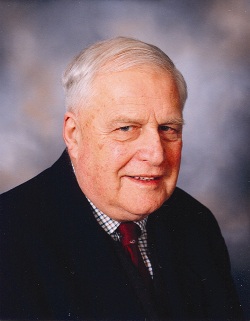
Joe McCall celebrates his 90th birthday this month. As the longest-standing contributor to Geoscientist, we salute him. He meanwhile has thoughts of his own…
Geoscientist 20.7 July 2010
I am not a palaeontologist, though have always maintained an interest and in fact once discovered a vertebrate fossil locality of unique age at Karmosit1, Baring district, Kenya, and carried in sacks of Miocene corals from the Makran, Iran, back to the Natural History Museum2. But reaching my 90th, and having been associated with Geoscientist virtually since its inception, I have found myself pondering two palaeontological topics that bother me - and I believe need an airing in these pages.
The Molecular Clock method of deriving branching ancestries that reach back to a common ancestor in the distant past, is widely used by palaeontologists, and indeed I have referred to it in my monograph on the Ediacara fauna3. However, I must admit that I have taken it on trust while the details of how it works have eluded me. Perhaps some expert could describe for our readers in detail the method’s nuts and bolts, in language that the non specialist can understand!
My other problem concerns what is known as 'cognition' – to which subject a special journal is solely devoted. Evolution is widely accepted as an “undesigned” process, mutations happening randomly, producing fortuitously changed organisms that enjoy an advantage over others, and benefit accordingly. There is, however, a problem in how information is communicated.
Dave Martill, whose articles I always find most stimulating, recently published a splendid small article on pterosaurs4. What intrigues me is how the very first organism to take to the air came to adopt flight. Did random “preadaptive” mutations just happen to be enable take-off, or did some system of communication “tell” the developing organism what was required to enable it to fly? A simpler example perhaps is the mimicry displayed by the butterfly Papilio dardanus, illustrated by Colin Patterson5. Is this mimicry the cumulative result of billions upon billions of accidental advantageous mutations being preserved by natural selection? I wonder by contrast if there is some form of transmission of knowledge that allows one butterfly to mimic another. Cognition permeates the history of life: is it fully understood? After 90 years, I remain baffled.
References
- McCall, G.J.H. 1999 . Silali volcano, Kenya: sedimentary structures at the western fringe. In: Andrews, P., Banham, P., eds. Late Cenozoic environments and hominid evotution: a tribute to Bill Bishop. geological Society; 59-68.
- McCall, G.J.H., Rosen, B.R., Darrell, J.G. 1994. Carbonate deposition in accretionary prism settings: Early Miocene coral limestones and corals of the Makran mountain range in Southern Iran. Facies 31; 141-178.
- McCall, G.J.H. The Vendian(Ediacaran) in the Geological Record: Enigmas in geology's prelude to the Cambrian explosion. Earth Science Reviews 77; 1-229
- Martill, D. 2010. Blessed are the toymakers: for they shall be palaeontologists too. Geoscientist 20(6); 12-13.
- Patterson, C. 1999. Evolution. Natural History Museum, London, 166 pp.